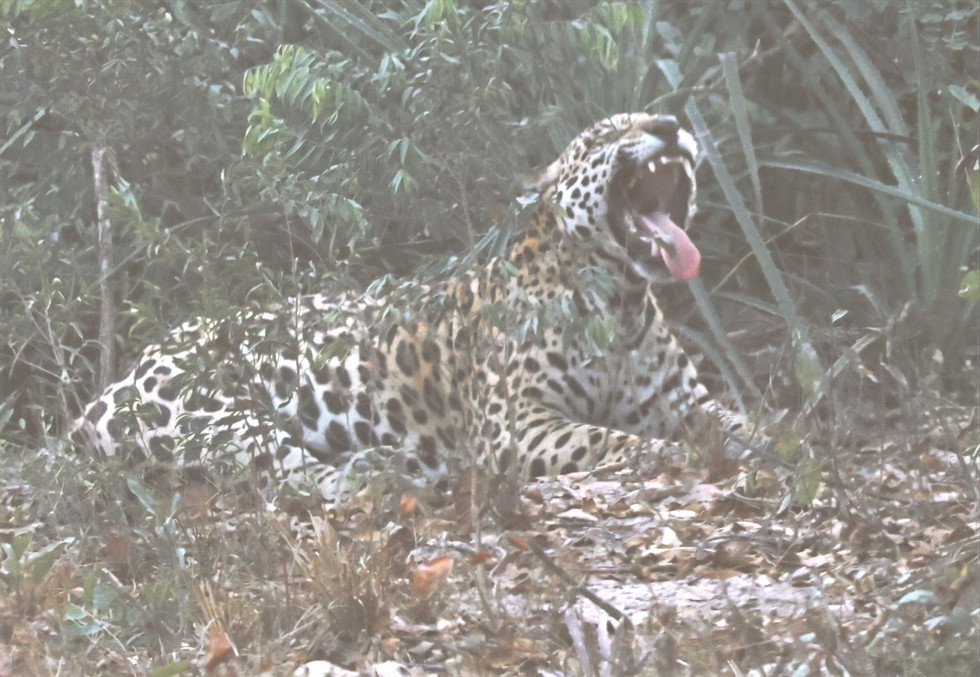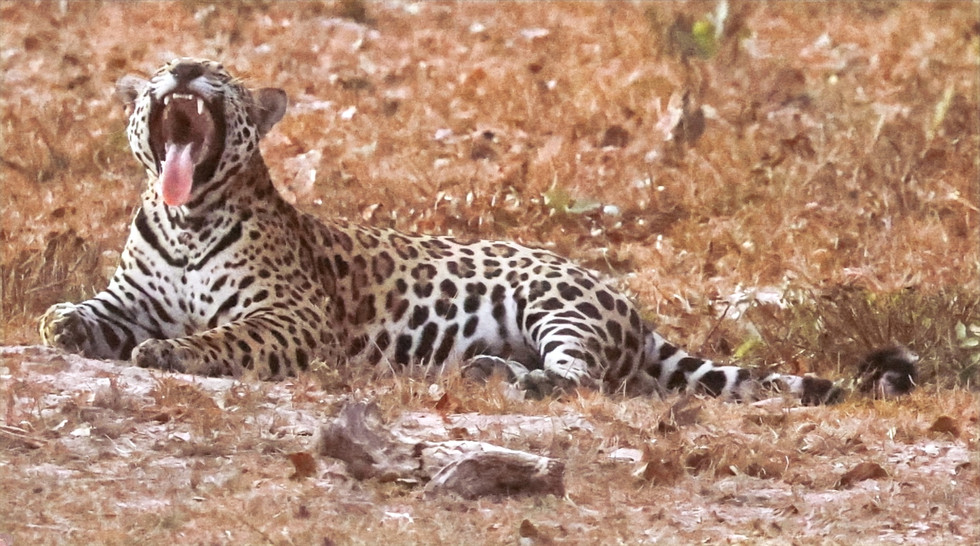Our guide, Fabi, picked us up from Hotel Deville. He would stay with us throughout our time in the North Pantanal, guiding us through our excursions at both the Pousada Piuval and Porto Jofre. He lives in the South Pantanal near Caiman Lodge so will get to retun and spend time with his family when we go to Caiman who provides its own guides.
On our drive into the lodge, we saw a couple caiman on the shore and some capybara in the distance. When we arrived at the Pousada Piuval, Fabi showed us around the lodge.
We saw a large lizard, but it disappeared down the drain before I could get my camera out. I did see a smaller Amazon lava lizard a bit later though.

After a brief tour, Fabi helped me spot birds. He is an expert with the birds of the Pantanal. In the trees, we spotted a monk parakeet. Although native to South American grasslands, this smart parakeet is popular pet as it can be taught to mimic human speech like some parrots. Fugitive parakeets from the pet trade have formed wild populations in large cities around the United States such as New York, Portland and Chicago.

The bright yellow male saffron finch was the next bird we spotted. Males are a brighter yellow than females and also have some orange coloring on the top of their heads.

The purplish jay was the next bird. It eats bugs and grubs and even small vertebrates, as well as plant matter. Sometimes it will even help larger mammals by eating their ticks.

We also saw a red-legged seriema wandering around the pousada. It's a handy bird to have around as it eats snakes - even the extremely venomous coral snake which has few other predators. It can run up to 40 miles per hour and rarely flies - although it can when necessary.

After a nice buffet lunch, we were able to check into our room. An hour later we were on our first safari. Our first sighting was a group of greater rheas, the largest bird in South America. Like the emus of Australia, the father cares for the young.

Soon after we saw a pair of caiman sunning themselves by the lodge water hole. One entered the water just as we passed. Caiman, the most numerous and most hunted of the crocodilians, as well as typically the smallest (the dwarf caiman is the smallest of them).


We saw several birds as we drove along. The buff-necked ibis will eat insects, spiders, snakes, lizards and even rats.

The rufous hornero, or red ovenbird, is the national bird of both Argentina and Uruguay.

The sunbittern is a unique bird. It is the only bird in the Eurypygidae family. It's closest relations are bustards and rails.

Seeing it fly was a treat as it displayed the chestnut-orange patches resembling eyes that help ward off predators and attract mates. Here you can see it ready to take off from the ground behind a cocoi heron.

The bare-faced curassow is a bit unique among birds as the female has the more colorful plumage. This photo shows a mated pair with the female on the left.

The southern lapwing is quite territorial and will fiercely defend its young from perceived threats either through deception such as pretending to have a broken wing to distract a predator or even mobbing a larger predator to drive it away from their babies.

The undulated tinamou is a shy bird that can often be difficult to see. The best chances are when it is crossing a road or path.

The hyacinth macaw is the largest of the parrots by length (although the kakapo in New Zealand weighs more). It is endangered because of habit destruction and its popularity in the pet trade.

The roadside hawk can often be seen hanging out on perches by roads. It is a clever and versatile hunter eating insects, other birds, and small mammals. It will seek out situations such as brush fires that will distract its prey. It will even follow army ant swarms to hunt the small animals that the swarm spooks.

Turkey vultures are a common scavenger throughout Central and South America. They have very acidic stomach acid that digests just about everything so they won't catch diseases like rabies from the carcasses they feast on.

The main objective of the evening safari was to find the jaguar. Our driver spotted some fresh tracks in the road.

Then the driver got a call that the jaguar and been spotted. We raced off to find the jaguar, scaring up a bunch of chaco chacalacas walking on the road.

Just as the sun was beginning to set, we reached our quarry. The jaguar was resting not too far off the road.
After a while, the jaguar wandered into the brush, but we searched for where it would reappear as the sun sank closer to the horizon.

We found it again before too long in a more open area this time.
We extended our safari to watch the jaguar and it was almost completely dark when we returned.

We thought we had missed the spot lighting, but we were in luck. We got back just in time!
We set off to find nocturnal animals by searching for glowing eyes. Eyes set close together tend to be predators and eyes wider apart the prey animals.

Overall, spotlighting was pretty uneventful. We did see some crab-eating foxes and a red brocket deer.


We had a nice buffet dinner. On the way back to our room, we admired the large number of capybara clustered around the pond outside our room.























Comments